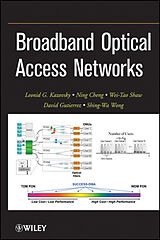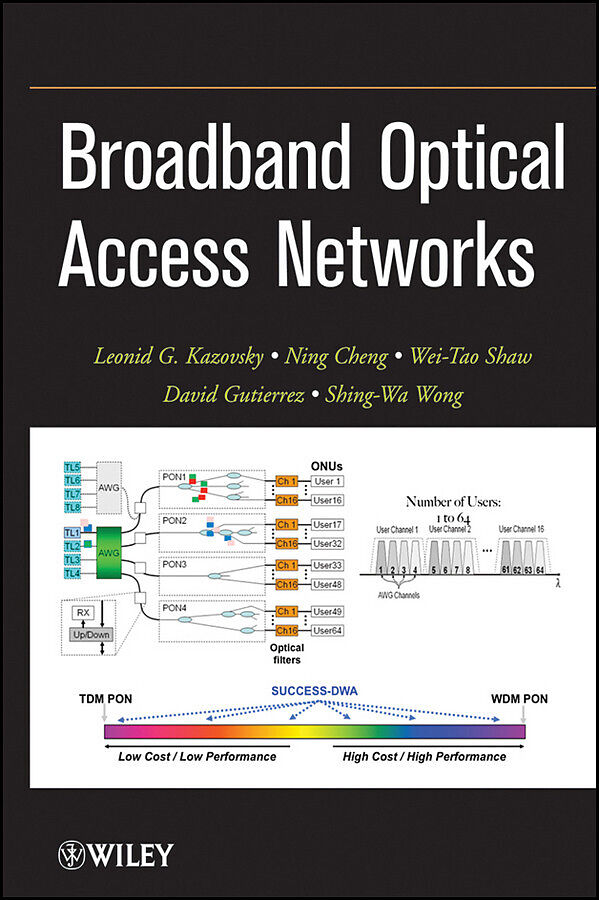Broadband Optical Access Networks
Einband:
E-Book (epub)
EAN:
9780470922675
Untertitel:
Englisch
Genre:
Elektronik, Elektrotechnik, Nachrichtentechnik
Autor:
Leonid G. Kazovsky, Ning Cheng, Wei-Tao Shaw, David Gutierrez, Shing-Wa Wong
Herausgeber:
Wiley-Interscience
Anzahl Seiten:
300
Erscheinungsdatum:
20.04.2011
ISBN:
978-0-470-92267-5
Broadband optical access network is an ideal solution to alleviate the first/last mile bottleneck of current Internet infrastructures. Richly illustrated throughout to help clarify important topics, Broadband Optical Access Networks covers the architectures, protocols enabling technologies of broadband optical access networks, and all current and future competing technologies for access networks. This comprehensive work presents the evolution of optical access networks, including reach extension, bandwidth enhancement, and discusses the convergence of optical and wireless technologies for broadband access, making it an invaluable reference for researchers, electrical engineers, and graduate students.
Autorentext
Leonid G. Kazovsky, PhD, is a professor in the Department of
Electrical Engineering at Stanford University. He is a Fellow of
the Institute of Electrical and Electronics Engineers (IEEE) and a
Fellow of the Optical Society of America (OSA). He is the founder
and director of the Photonic and Networking Research Laboratory and
is recognized for his outstanding research contributions to
coherent optical communications and optical access networks.
Ning Cheng, PhD, is a senior engineer at a major
technology company as well as the author of more than sixty
technical papers in electrical engineering. He served as a
postdoctoral research fellow at Stanford University.
Wei-Tao Shaw, PhD, is currently a member of the technical
staff at Infinera Inc. During his time at Stanford University, he
worked in the Photonics and Networking Research Lab where he
focused on optical access networks and subsystems, and hybrid
optical and wireless access networks.
David Gutierrez, PhD, currently advises the Colombian
Ministry of Information Technologies and Communications. While at
Stanford University, his research focused on next-generation access
networks. His work has been published in many scientific journals
and conference proceedings.
Shing-Wa Wong, PhD, graduated with a degree in electrical
engineering from Stanford University. He has published more than
twenty-five IEEE journal and conference publications and obtained
three patents in next-generation broadband networks.
Klappentext
An invaluable reference to all aspects of current and next-generation broadband optical access networks Service providers across the globe are responding to copper wire bandwidth limits in an effort to alleviate the so-called first/last mile bottleneck of Internet infrastructures. This comprehensive work covers the architectures and the enabling technologies of broadband optical access networks and outlines all current and future competing technologies. Rich illustrations clarify important topics as the book explores both current passive optical network standards and next-generation broadband optical access networks. This text presents the evolution of optical access networksincluding reach extension, bandwidth enhancement, and service overlayand discusses the convergence of optical and wireless technologies for broadband access. It explains different design approaches to broadband optical access networksoutlining the economical and technological boundariesand discusses new national network initiatives, particularly with respect to access networks. The book investigates hybrid optical and wireless networks for key technologies, integrated routing algorithms, and traffic engineering. Broadband Optical Access Networks is an invaluable reference for upper-level undergraduate students and graduate students studying telecommunications, optical networking, photonics, wireless communications, and/or networking/computer science. It is also an optimal text for researchers, electrical engineers, and managers in the telecommunications industry.
Inhalt
FOREWORD. PREFACE. ACKNOWLEDGMENTS. 1 BROADBAND ACCESS TECHNOLOGIES: AN OVERVIEW. 1.1 Communication Networks. 1.2 Access Technologies. 1.2.1 Last-Mile Bottleneck. 1.2.2 Access Technologies Compared. 1.3 Digital Subscriber Line. 1.3.1 DSL Standards. 1.3.2 Modulation Methods. 1.3.3 Voice over DSL. 1.4 Hybrid Fiber Coax. 1.4.1 Cable Modem. 1.4.2 DOCSIS. 1.5 Optical Access Networks. 1.5.1 Passive Optical Networks. 1.5.2 PON Standard Development. 1.5.3 WDM PONs. 1.5.4 Other Types of Optical Access Networks. 1.6 Broadband over Power Lines. 1.6.1 Power-Line Communications. 1.6.2 BPL Modem. 1.6.3 Challenges in BPL. 1.7 Wireless Access Technologies. 1.7.1 Wi-Fi Mesh Networks. 1.7.2 WiMAX Access Networks. 1.7.3 Cellular Networks. 1.7.4 Satellite Systems. 1.7.5 LMDS and MMDS Systems. 1.8 Broadband Services and Emerging Technologies. 1.8.1 Broadband Access Services. 1.8.2 Emerging Technologies. 1.9 Summary. References. 2 OPTICAL COMMUNICATIONS: COMPONENTS AND SYSTEMS. 2.1 Optical Fibers. 2.1.1 Fiber Structure. 2.1.2 Fiber Mode. 2.1.3 Fiber Loss. 2.1.4 Fiber Dispersion. 2.1.5 Nonlinear Effects. 2.1.6 Light-Wave Propagation in Optical Fibers. 2.2 Optical Transmitters. 2.2.1 Semiconductor Lasers. 2.2.2 Optical Modulators. 2.2.3 Transmitter Design. 2.3 Optical Receivers. 2.3.1 Photodetectors. 2.3.2 Optical Receiver Design. 2.4 Optical Amplifiers. 2.4.1 Rare-Earth-Doped Fiber Amplifiers. 2.4.2 Semiconductor Optical Amplifiers. 2.4.3 Raman Amplifiers. 2.5 Passive Optical Components. 2.5.1 Directional Couplers. 2.5.2 Optical Filters. 2.6 System Design and Analysis. 2.6.1 Receiver Sensitivity. 2.6.2 Power Budget. 2.6.3 Dispersion Limit. 2.7 Optical Transceiver Design for TDM PONs. 2.7.1 Burst-Mode Optical Transmission. 2.7.2 Colorless ONUs. 2.8 Summary. References. 3 PASSIVE OPTICAL NETWORKS: ARCHITECTURES AND PROTOCOLS. 3.1 PON Architectures. 3.1.1 Network Dimensioning and Bandwidth. 3.1.2 Power Budget. 3.1.3 Burst-Mode Operation. 3.1.4 PON Packet Format and Encapsulation. 3.1.5 Dynamic Bandwidth Allocation, Ranging, and Discovery. 3.1.6 Reliability and Security Concerns. 3.2 PON Standards History and Deployment. 3.2.1 Brief Developmental History. 3.2.2 FTTx Deployments. 3.3 Broadband PON. 3.3.1 BPON Architecture. 3.3.2 BPON Protocol and Service. 3.3.3 BPON Transmission Convergence Layer. 3.3.4 BPON Dynamic Bandwidth Allocation. 3.3.5 Other ITU-T G.983.x Recommendations. 3.4 Gigabit-Capable PON. 3.4.1 GPON Physical MediumDependent Layer. 3.4.2 GPON Transmission Convergence Layer. 3.4.3 Recent G.984 Series Standards, Revisions, and Amendments. 3.5 Ethernet PON. 3.5.1 EPON Architecture. 3.5.2 EPON Point-to-Multipoint MAC Control. 3.5.3 Open Implementations in EPON. 3.5.4 Unresolved Security Weaknesses. 3.6 IEEE 802.av-2009 10GEPON Standard. 3.6.1 10GEPON PMD Architecture. 3.6.2 10GEPON MAC Modifications. 3.6.3 10GEPON Coexistence Options. 3.7 Next-Generation Optical Access System Development in the Standards. 3.7.1 FSAN NGA Road Map. 3.7.2 Energy Efficiency. 3.7.3 Other Worldwide Development. 3.8 Summary....

Leider konnten wir für diesen Artikel keine Preise ermitteln ...
billigbuch.ch sucht jetzt für Sie die besten Angebote ...
Die aktuellen Verkaufspreise von 6 Onlineshops werden in Realtime abgefragt.
Sie können das gewünschte Produkt anschliessend direkt beim Anbieter Ihrer Wahl bestellen.
Loading...
Die aktuellen Verkaufspreise von 6 Onlineshops werden in Realtime abgefragt.
Sie können das gewünschte Produkt anschliessend direkt beim Anbieter Ihrer Wahl bestellen.
| # | Onlineshop | Preis CHF | Versand CHF | Total CHF | ||
|---|---|---|---|---|---|---|
| 1 | Seller | 0.00 | 0.00 | 0.00 |
